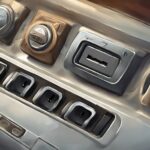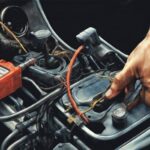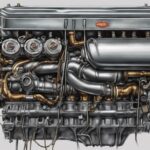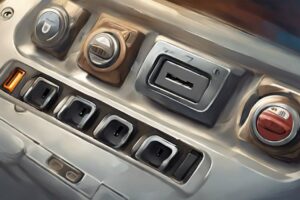The most common symptoms of a faulty starter solenoid are a car that won’t start and a clicking sound when you try to start the engine.
The starter solenoid is attached to, or is part of the starter motor. Its job is to act as a switch that turns on the starter motor when you start the ignition. When it gets the signal, it takes the power from the car battery and closes a switch so that this power can be used to turn the starter motor and the engine.
There are many reasons why a starter solenoid can fail to work properly. Sometimes the solenoid can be fine and the problem can be with the battery or the starter motor.
Symptoms Of A Faulty Starter Solenoid
If you’re wondering how to tell if a starter solenoid is faulty, one of the most common symptoms is a lack of response from the starter when you turn the key. Usually there will be no engine cranking or noises at all.
Other potential signs of a faulty starter solenoid include a clicking sound when turning the key, dimming headlights or interior lights, or a burning smell coming from the starter.
Before you start to get your hands dirty, here are a few common symptoms of a faulty starter solenoid:
1. Clicking Sound Coming From The Starter Motor
A clicking sound coming from the starter motor is a common symptom that may indicate that the solenoid is faulty. When you turn the key to start your car, the starter motor engages with the engine’s flywheel or flexplate and begins turning the engine over.
The solenoid is responsible for engaging the starter motor with the flywheel or flexplate. If the starter solenoid is faulty, it may not be able to fully engage with the flywheel, causing it to make a clicking sound instead of turning the engine over.
The clicking also indicates that the starter solenoid is getting adequate power from the battery, but is failing to start the engine, meaning the battery is not at fault.
2. Starter Motor Keeps Running After The Engine Starts
If the starter motor keeps running after the engine starts, it can be a sign that the starter solenoid is faulty. The starter solenoid is responsible for engaging the starter motor with the engine’s flywheel when you turn the key to start your car. Once the engine starts, the solenoid should disengage the starter motor from the flywheel or flexplate to prevent it from continuing to spin.
If the starter solenoid is faulty, it may not disengage the starter motor from the flywheel after the engine starts. This can cause the starter motor to continue running, even though the engine has already started.
3. The Engine Will Start Sometimes
If the starter solenoid is faulty, it’s possible for the engine to start sometimes and not others. The starter solenoid is responsible for engaging the starter motor when you turn the key to start your car. If the solenoid is faulty, it may not be able to consistently engage the starter motor with the flywheel, causing intermittent starting problems.
A fault with the internal wiring or switching mechanism in the starter solenoid can also cause intermittent starting problems.
4. There Is No Sound When Trying To Start The Engine
A faulty starter solenoid can mean that there is no sound when trying to start the engine. The starter solenoid is responsible for engaging the starter motor with the engine’s flywheel and if the solenoid is faulty, it may not be able to engage the starter motor at all, causing no sound to be produced when you turn the key.
The starter solenoid may also be completely dead, or may not be receiving power from the battery if the battery is dead or if the battery cables are damaged. It can also point to problems with engine loom wiring or a blown fuse.
What Next – How To Diagnose If The Starter Solenoid Is Faulty?
If your car won’t start sometimes or if it won’t start at all, then there is probably a problem with the starter relay, starter solenoid, the battery or the starter motor.
Sometimes the check engine light will come on when the engine doesn’t start, and this is a sure sign that there is a problem with the starter relay circuit.
In my experience, most of the time the starter solenoid is not at fault. Usually it’s a faulty ignition switch, faulty starter motor or a problem with the wiring that is to blame.
The best way to fast track the diagnosis of the problem is to hook up a diagnostic reader (OBD-II Scan Tool) to see if there are any fault codes stored in the ECU. I always do this before I even open the hood, as it can really save time trying to figure out what’s wrong with a car.
The most common P codes associated with a car that will not start are as follows: P0615 – Starter Relay Circuit, P0616 – Starter Relay Circuit Low and P0617 – Starter Relay Circuit High.
If you see one or more of these error codes then the problem is with one or more of the components in the starter circuit.
If only P0615 is present then there is a good chance that the starter solenoid is faulty. P0615 will be recorded if the starter solenoid remains on after the engine has started and the car is in gear. If the engine doesn’t start at all, then the problem most likely is with another component.
How To Test A Starter Solenoid
A starter solenoid is like a big switch that transfers power from the battery to the starter motor. They are usually pretty robust, but I have seen a few that develop faults, usually in older vehicles. They are generally easier to replace than to repair, but they are also easy to test.
- Locate the starter motor and the solenoid. Most modern vehicles have the solenoid attached to the starter motor.
- You should see two wiring terminals on the solenoid, one will be the positive going back to the battery and the other will be the feed to the starter motor.
- Check that there is power getting to the positive terminal using a multimeter or circuit tester.
- If there is power getting to the starter solenoid then you need to check that the solenoid is working. Do this by checking the other terminal on the starter solenoid while trying to start the car.
- If the solenoid is switching properly then the other terminal will be live when the ignition switch is on.
If the starter solenoid is not switching properly, ie the switched terminal is dead when the ignition is on, then the best course of action is to replace the solenoid if possible.
How To Replace A Starter Solenoid
In many vehicles the starter solenoid can be replaced, without having to replace the entire starter motor.
Before you attempt to do any work on the starter motor, always disconnect the battery completely. Replacing the solenoid is fairly easy, but usually involves removing the entire starter motor from the vehicle.
The following is a rough outline of the steps involved in replacing a starter solenoid, refer to a vehicle specific manual for detailed steps.
- Disconnect the car battery.
- Locate the starter motor, this may involve removing some hoses, pipes, engine covers and air filter boxes.
- Locate the wiring connectors on the starter motor and make note of the wiring sequence. I usually use a smartphone camera to take a snap of the wiring before I disconnect anything (this can come in handy later!)
- Disconnect the positive and negative cables from the starter motor. You’ll probably need a small socket wrench to undo the connections. Be careful not to drop the nuts when loose!
- Now remove the bolts that are holding the starter motor onto the engine block. You may need access to the underneath of the car to get to all of them.
- Carefully remove the starter motor from the engine and move it to a bench where you can inspect the starter solenoid.
- Before removing the solenoid, check the condition of the starter motor. You are looking for worn or rusted parts, frayed wiring and any signs of burning.
- If it all looks ok, then remove the starter solenoid screws and pull off the solenoid.
- Compare the new solenoid to the old one, making sure they are identical in shape and size with the same connectors.
- Fit the new solenoid to the starter, and refit the starter to the car. Make sure to torque all bolts and double check the wiring connectors to ensure they are tight.
- Now, reconnect the battery and test the new solenoid by starting the car.
Don’t forget to clear any error codes stored in the ECU before driving the car.











I’m experiencing a problem where my car won’t start, and I hear a clicking sound when I turn the key. I suspect it might be related to the starter solenoid. How can I diagnose if the starter solenoid is indeed the issue?
Given these symptoms and testing methods, what should I do if after replacing the solenoid, the car still won’t start and I hear the same clicking sound?